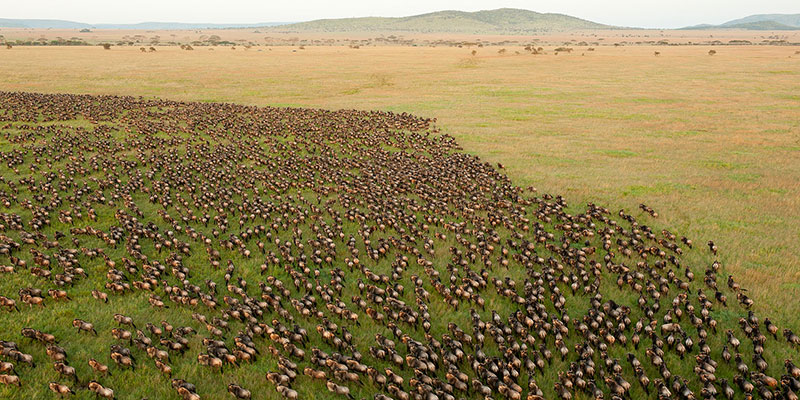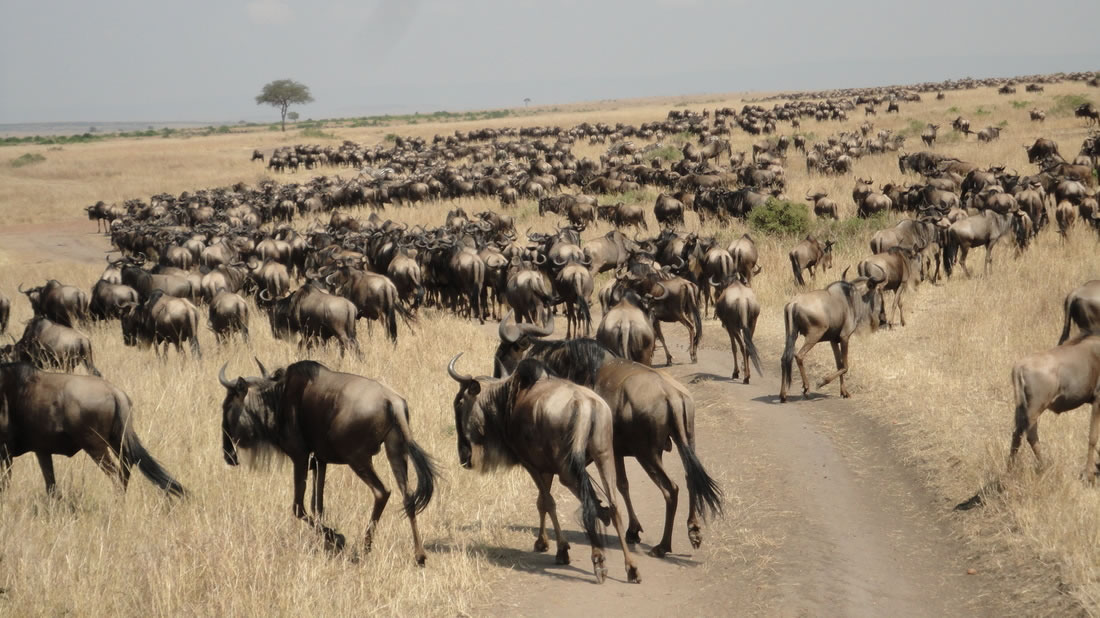

The Wildebeest Migration Safari Masai Mara was included as one of the seventh greatest wonders of the modern world.” It is now officially known throughout the world. Many have come back time and again. They have witnessed this mass movement of wild animals roaming free through the unspoiled and savage wilderness. The air fills with the click-click of the cameras. You have not seen something like this before.
Africa is changing quickly, and human encroachment into the wildlife reserves has continued erasing traditional migration routes. In association with the development and changes in the way of life, the image of wildlife roaming free is slowly getting deleted. Fortunately, Masai Mara National Reserve retains its charisma of open, limitless land. It is one of the places in Africa that still prides itself on wildlife concentration.
Masai Mara is located in the southwestern of Kenya, 290 kilometers from Nairobi. The abundance of wildlife and the remoteness of the reserve implants memories that no money can buy.
Migration is a recent phenomenon (the ’60s and ’70s was the biggest boom), with about 250,000 individuals. Gradually, with time, the number has risen to the current population of over 3,000,000 individuals. Add to it an estimated 1,500,000 Zebras, and the result is one of the most magnificent scenes in the world. The massive display attracts hundreds of big cats as the populations provide abundant prey. The giant African crocodiles lie in wait, patiently, as the big herds come to cross the river or to drink.
It is the Masai community who are not so pleased with the whole phenomenon. The wildebeests compete with their vast herds of Borana cattle for the grasslands. To them, it is a big calamity, especially because the wildebeests transmit diseases to their flocks and poison the waters with their fetal sacs.
This world-famous migration is a circle of life, which, in simple terms, means that there isn’t a start or an end. Only where the herds are located at a particular time. The significant determinant is the availability of pastures. The plains of Ngorongoro Conservation Area in Serengeti are a favored spot as grass abounds and the wildebeest find a safe place to graze. It is also here that over 500,000 new calves are born, and the nearby waiting jackals or hyenas take many.
Newborns have little time to strengthen their legs. As soon after birth, the “pilgrim” continues. By April, the rains are over in southern Serengeti, and the plains have dried up. The vast herds then gather and face the long march northwards and westwards. The natural lawnmowers abandon the exhausted grasslands of southern Serengeti to head for the already tall grass of the Western corridor, near the shores of Lake Victoria.
The pioneers of the migration movement are the majestic herds of zebras. They prefer the long stems of the coarse grass. This way, they leave behind shorter grass, which the wildebeests favor.
From late June to July, the mass starts pouring into the Kenya Masai Mara reserve, where fresh, tender, and mineral-rich grass is already waiting. Here, they meet the resident Mara populations of about 150,000. Also commonly referred to as the Loita plains herds, they spend most of the season northeast of the Mara. When it gets dry, they pour into the interior of the Mara in search of greener pastures.
The migrating herds spend roughly 3 to 3 and a 1/2 months in the Mara, crossing through Sand River, which is a tributary of the Mara along the boundary of Kenya and Tanzania. They trek westwards and cross the Mara River and sometimes the Talek River. Usually, around this time, heavy rains on the Mau Escarpment (the origin of the Mara River) fill the Mara River to the brim.
This is a good time to watch the trunk-looking crocodiles while they await the forthcoming feast. Finally, the gnus (wildebeests) venture into the river. This gregarious, coordinated behavior of the herds, usually teamed with zebras, creates an incredible scene. That’s just what the cameras have been waiting for.
They wander along the river looking for a convenient crossing point. This moment is filled with tension for both the gnus(wildebeests) and the audience. They survey for a less steep part of the river bank and with no obvious danger. Finally, one takes courage and plunges into the river, and magically, the rest fall into the footsteps and, in one organized line, cross the river.
In addition to the crocodiles, accidents also occur. The river’s current can be too strong for some, especially the young ones. Or getting stuck between the rocks in the river and breaking limbs, a direct ticket to the jaws of the giant crocodiles. Finally, the crossing is done, and the trek to their unknown (or known) destiny continues.
Maasai Mara Serengeti wildebeest migration safari in the month of October, they are already heading to Serengeti, where the rains have treated the southern grasslands to a lush, green carpet of rich grass. Once again, they are heading to the southern plains, where a new generation will be born to start the life cycle all over again.
Distance: 275 km (5 hrs) Pick up at your Nairobi Hotel at 7:00 AM in the morning and drive via the Great Rift Valley View Point to Narok town, where you have a bathroom stopover. Drive on to Masai Mara, arriving for lunch. Have an afternoon game drive, watching the amazing migration, the concentration of wildlife, and the outstanding scenery. Overnight at MARA ENGAI LODGE,
Lunch, Dinner
Have breakfast and head out with packed lunch for a full-day game drive in the finest game sanctuary in Kenya, noted for its wildebeest migration, lions, and other wildlife. Lunch at a picnic site before continuing on your afternoon game drive. Dinner and overnight at MARA ENGAI LODGE.
Breakfast, Lunch, Dinner
Full day in Maasai Mara with a morning and afternoon game drive. All meals and overnight at MARA SERENA LODGE
Breakfast, Lunch, Dinner
Have an early morning game drive and breakfast, then depart for Nairobi, where you arrive in the late afternoon where your safari ends.
Breakfast, Lunch
Optional Activities:
Balloon Safari at $435 per person
Masai Village Visit $25 per person
-All park entrance fees
-Accommodation at Mara eNGAI Lodge on full board.
-1 liter per person per day bottled water for use during the safari
-Services of an English-speaking experienced driver/guide
-Transport in a 4 x 4 Safari Land cruiser with pop up roof for easier game viewing and photography. Exclusive use of safari vehicle throughout the duration of the trip
– Meals as in itinerary
– All government taxes and levies
– Flying doctors air ambulance evacuation in case of a life-threatening accident or injury
– Safari accessories (First Aid kit, cool box and fire extinguisher) Emergency number 24 hours. All safari vehicles are equipped with RF radio.
– Driver tips
– All soft and alcoholic drinks
– Balloon safari
– Masai village visit
– Expenses of a personal nature, such as visas, etc
– Any other expenses not noted above
